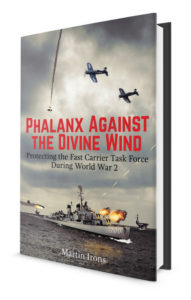Books about Task Force 58/38
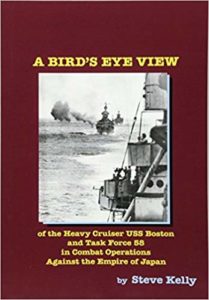 A Bird’s Eye View
A Bird’s Eye View
by Steve Kelly
Experience this remarkable group of ships’ dramatic combat operations as seen through the eyes of Signalman 1st Class William Kelly from his vantage point high above the decks on the signal bridge of the heavy cruiser CA-69 the USS Boston. Read as the great offensive campaigns unfold: the capture of the Marshall & Mariana Islands, the operations to liberate the Philippines; Iwo Jima, Okinawa and the attacks on Japan itself. Experience the devastating Typhoon Cobra. Read about the famous Battles of the Philippine Sea, the Marianas Turkey Shoot; the nail-biting tow of the crippled heavy cruisers Canberra and Houston damaged in the Battle of Formosa, and the tragic sinking of the Indianapolis.
A Bird’s Eye View of the Heavy Cruiser USS Boston and Task Force 58 in Combat Operations Against the Empire of Japan
by Steve Kelly
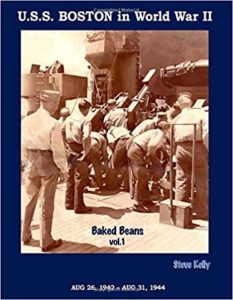 Baked Beans Vol. 1
Baked Beans Vol. 1
by Steve Kelly
Only primary-source historical materials (documents, photos, diaries, and first-hand accounts) are used in these books, with occasional overview statements from the author lightly sprinkled throughout. Source materials include the ship’s and Task Force Action Reports, War Diaries, Decklogs and official Navy Photos from the Boston folders at the National Archives. Additionally, sailor’s notes, documents, diaries and anecdotes flesh out the story from their points of view. The author interviewed six surviving Original Crewmembers and one Officer; their stories putting on the finishing touches. The Baked Beans Series chronicles the heavy cruiser CA-69 Boston from her christening in the Fore River (Quincy, MA) Shipyard in August 1942 until she leaves Japanese waters for the last time in January 1946. The incredible story is told through the eyes of her mostly 19 year-old enlisted men’s point of view. The story of the Boston IS the story of Task Force 58 and vice-versa.
Volume 1 – covers the first part of the Central Pacific War, including the capture of the Marshall Islands, Battle of the Philippine Sea (“Great Marianas Turkey Shoot”), and the securing of the Mariana Islands.
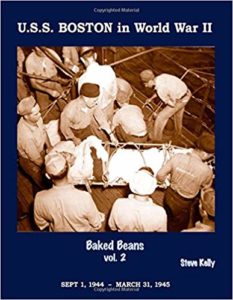 Baked Beans Vol. 2
Baked Beans Vol. 2
by Steve Kelly
Available on Amazon
Only primary-source historic materials (documents, photos, diaries and first hand accounts) are used in this book, with occasional overview statements by the author lightly sprinkled throughout. Source materials include the ship’s and Task Force Action Reports, War Diaries, Decklogs, and official Navy photos from the Boston folders at the National Archives. Additionally, sailor’s notes, documents, diaries and anecdotes flesh out the story from their points of view. The author interviewed six surviving Original Crewmembers and one Officer; their stories putting on the finishing touches. The Baked Beans Series chronicles the heavy cruiser CA-69 Boston from her christening in the Fore River (Quincy, MA) Shipyard in August 1942 until she leaves Japanese waters for the last time in January 1946. The incredible story is told through the eyes of her mostly 19 year-old enlisted men’s perspective. The story of the Boston IS the story of Task Force 58 and vice-versa.
Volume 2 covers an intense six month period starting September 1, 1944 that includes diverse Philippines Operations, attacks on the Bonin Islands and Formosa, the torpedoing of two U.S. cruisers off Formosa and the ensuing 1200 mile retreat (the Streamlined Bait Ordeal), attacks in the South China Sea, the deadly TYPHOON COBRA that claimed more than 800 lives, and the landings at Iwo Jima. The ship is ordered back to the States for critical repairs and radar upgrades just as Okinawa begins. The book ends when the cruiser sails into the Navy Yard at San Pedro, CA, March 26, 1945.
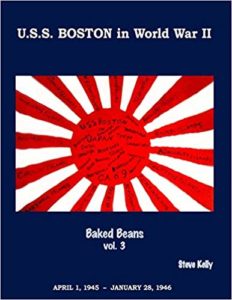 Baked Beans Volume 3
Baked Beans Volume 3
by Steve Kelly
Available on Amazon
U.S.S. Boston in World War II, Baked Beans Vol. 3″ is a major revision of “Baked Beans Vol. 3” – which is a follow-up to “A Bird’s Eye View,” the story of the heavy cruiser USS Boston CA-69 and her exploits during WW II.
Only primary-source historic materials (documents, photos, diaries and first hand accounts) are used in this book, with occasional overview statements by the author lightly sprinkled throughout. Source materials include the ship’s and Task Force Action Reports, War Diaries, Decklogs, and official Navy photos from the Boston folders at the National Archives. Additionally, sailor’s notes, documents, diaries and anecdotes flesh out the story from their points of view. The author interviewed six surviving Original Crewmembers and one Officer; their stories putting on the finishing touches. The Baked Beans Series chronicles the heavy cruiser CA-69 Boston from her christening in the Fore River (Quincy, MA) Shipyard in August 1942 until she leaves Japanese waters for the last time in January 1946. The incredible story is told through the eyes of her mostly 19 year-old enlisted men’s perspective. The story of the Boston IS the story of Task Force 58/38 and vice-versa.
In Volume 3 the ship returns to the War in the Pacific after undergoing major repairs and retrofits in San Pedro, CA. She rejoins Task Force 38 off the shores of Japan and returns to her station in the task groups in late July. Marine Capt Norman C. Bayley comes aboard as the new commander of the Marine Detachment and is shortly thereafter visited by an Admiral and give a top secret mission: to investigate the effects and identify ground zero hours after the bombs were dropped on Hiroshima and Nagasaki. His incredible story is presented in his own words in this book. Armistice day (8/16) is soon followed by the Signing of the Surrender (9/2), but the men do not get to go home. The ship has been assigned to Occupation Duty – the demilitarization of coastal towns, defensive locations and hundreds of hidden caves that held arms, suicide boats, midget submarines and various bombs and weapons. The Boston left Japanese waters on January 28, 1946 and headed for San Francisco.
Phalanx Against the Divine Wind
by Martin Irons
The author sent us this review from the Tin Can Sailors website:
Reviewer: Bernie Ditter
Overall Rating: Four Stars: Highly recommended. An excellent book.
The author, Martin Irons, is the son-in-law of Jack McAllister, a plank holder of the USS Haynsworth (DD-700). Following two trips to the Haynsworth’s annual reunion with his wife and Jack and hearing from so many sources about the history of the ship and its crew during the largest kamikaze attack on the US Navy ever, he began writing an homage to Jack that evolved into a much larger objective.
The result is his first book, Phalanx Against the Divine Wind: Protecting the Fast Carrier Task Force During World War 2. The most significant portion of this book is an accounting of the two day assault on the Fifth Fleet by more than 700 Planes. Preceding this action were battles from the South China Sea, Iwo Jima, Tokyo and subsequently Okinawa.
Martin Irons is a former Army Reserve office and is a trained research specialist; which accounts for his compendium of names, histories and written account of events on board the Haynsworth. His accounting of battles by the navy from the Philippines north to the closing days of the war following the taking of Okinawa and the bombing of Hiroshima and Nagasaki are replete with facts and close-up descriptions of those events.
This was the best reading of the Pacific Fleets battles since James D. Hornfischer’s The Last Stand of the Tin Can Sailor. I could make no better recommendation that that.
Phalanx Against the Divine Wind: Protecting the Fast Carrier Task Force During World War 2 By Martin Irons (513 pages, pictures, drawings, maps)
Availability: Amazon, Barnes & Noble
Please let us know your recommendations or requests for books to add to this page. Contact us here.
